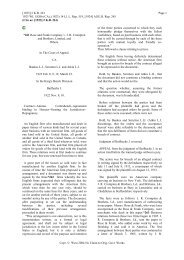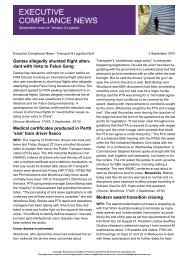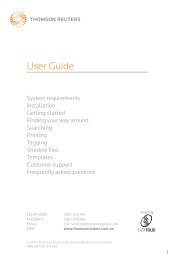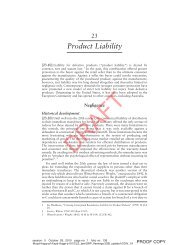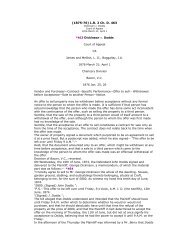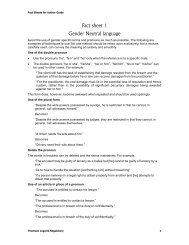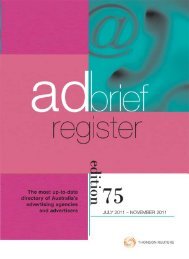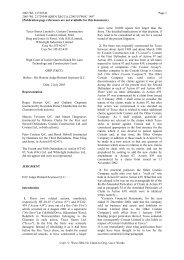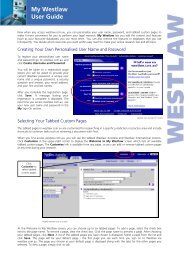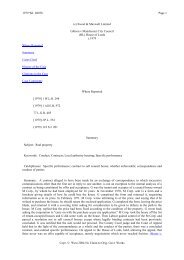Holmes v Jones - Thomson Reuters
Holmes v Jones - Thomson Reuters
Holmes v Jones - Thomson Reuters
- No tags were found...
Create successful ePaper yourself
Turn your PDF publications into a flip-book with our unique Google optimized e-Paper software.
4 CLR 1692 Page 71907 WL 12437 (HCA), 14 ALR 89, 7 SR (NSW) 821(Cite as: 4 CLR 1692)in contradiction earlier. The Statute, in effect, putsevidence of that sort on the same footing as anyother evidence to contradict, and if the evidencesought to be contradicted is first given by theplaintiff in reply, the defendant is entitled to answerit on the ground that it is new matter. I express thatopinion because it is a point of the general interest,and because the learned Chief Justice appears tohave taken the opposite view. In the present case,however, I do not think that the proper foundationwas laid in cross-examination for the admission ofthe evidence.For the reasons I have given I think that the appealshould be allowed and that a verdict should beentered for the defendants on the first count.O'Connor J.I am of the same opinion and have very little to addon the facts, but I wish to make some observationson the two grounds of law upon which theappellants relied. Their application was to have theverdict for the plaintiffs on the first count set asideand judgment entered for them. To succeed in thatthey must satisfy the Court that there was noevidence on which as a matter of law the jury couldhave found for the plaintiffs upon the first count. Inother words, they must show that there were nofacts in evidence from which the jury couldreasonably draw the inference that must be drawnbefore the plaintiffs can succeed. Now, there isonly one representation which is in question here.The facts and the course the case has taken havemade the other representations immaterial. The onematerial representation is that there were on thestation 1,337 cattle of the number 3 brand andolder. I take it that the reference to number 3 meansthis:-The cattle calved in that year were branded asof that year, and therefore the representation as tothe number of the brand contains a representationas to the age. I think it may be assumed, whendealing with the case from the point of view whichI am now putting, there was evidence for the jurythat the statement made by Trebeck, and *1706authorized by Sefton's letter of 20th September,that there were at the time of the statement 1,337cattle of the number 3 brand on the station, was astatement that was fraudulent in the legal sense.And I think it may also be taken that, if the offer ofTrebeck of 20th November in respect of which thestatement was made was at that time accepted,there would have been some ground upon whichthe jury might have come to the conclusion that thecontract thus made had been induced by fraudulentmisrepresentation. But before the plaintiffs cansucceed they must go much beyond that. They mustshow, not only that the representation wasfraudulent, but also that that fraudulentrepresentation induced the contract which wasafterwards entered into upon 3rd January. It is uponthat part of the case it seems to me that theplaintiffs have entirely failed to put before the jurysufficient evidence to justify the jury as reasonablemen in coming to the conclusion to which theycame. Now, the requirements of the law withrespect to false representations materially inducinga contract is very clearly stated by Sir John RomillyM.R. in the case of Pulsford v. Richards (1):-"Withrespect to the character or nature of themisrepresentation itself, it is clear that it may bepositive or negative; that it may consist as much inthe suppression of what is true, as in the assertionof what is false; and it is almost needless to add,that it must appear that the person deceived enteredinto the contract on the faith of it. To use theexpression of the Roman law, so much commentedupon in the argument before me, it must be arepresentation dans locum contractui, that is, arepresentation giving occasion to the contract, theproper interpretation of which appears to be theassertion of a fact, on which the person enteringinto the contract relied, and in the absence of whichit is reasonable to infer he would not have enteredinto it, or the suppression of a fact, the knowledgeof which it is reasonable to infer would have madehim abstain from the contract altogether." Wetherefore have to inquire whether there was anyevidence from which the jury could reasonablydraw the inference that it was the assertion made on20th November with regard to the *1707 numbersof these cattle, of number 3 and older, that inducedthe making of the contract of 3rd January.Now, it is true that, if a fraudulent statement ismade which is calculated to induce the person towhom it is made to enter into the contract, theinference may be drawn that the statement wasmade with the intention of inducing the contract.But that is an inference which may be rebutted bythe facts. It appears to me that in this case the factsaltogether rebut the inference that themisrepresentation in the proposal of Trebeck of20th November was an inducing cause in themaking of the contract. It is true that Mr. Burgesshimself swears that he did believe the statement tobe true, and that that induced him to make thepurchase. But that is of no moment whatever if, asa matter of fact, it was not reasonable on his part todraw that conclusion. If the person who is offeringan article for sale acts in such a way that anothermay reasonably infer that a certain representation istrue, that representation may be taken to have beenCopr. © West 2004 No Claim to Orig. Govt. Works



